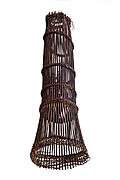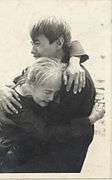Vietnamese Women’s Museum
|
| |
| Established | 1995 |
|---|---|
| Location | 36 Ly Thuong Kiet Str, Hoan Kiem, Hanoi |
| Coordinates | 21°01′24″N 105°51′06″E / 21.023463°N 105.851619°E |
| Director | Nguyen Thi Bich Van |
| Public transit access | Bus: 08, No 31, No 36, No 49 |
| Website | Official website |
Vietnamese Women’s Museum is located in Hanoi, in Ly Thuong Kiet Street, near the central Hoan Kiem Lake and the old quarter. This museum is dedicated to Vietnamese women.
The museum opened to public in 1995 and had been renovated between 2006 and 2010. More than 1000 materials, photos and objects displayed in the permanent exhibition show the role the Vietnamese women played in the History and currently play in Arts and in the Family life. The museum also organizes thematic exhibitions to show changes and development of the contemporary society.
The stated mission of the museum is "to enhance public knowledge and understanding of history and cultural heritage of Vietnamese women... thus contributing to promoting gender equality."[1]
History
Vietnamese Women’s Museum was established in 1987, and run is by the Vietnam Women’s Union. The construction started on an existing building in 1991, according to architect Tran Xuan Diem plans, and opened to the public in 1995.[2] The exhibition presents objects from a large collection (around 28,000 items) gathered by the museum and the Vietnam Women’s Union since the 1970s.[3] Those artefacts are related to the role of women in family life and history.
From 2006 to 2010, the museum was closed for modernisation, with funds from the Vietnamese Government, the Vietnamese Women’s Union, and the Ford Foundation. The Vietnamese Women’s Museum reopened to the public in 2010, with a contemporary architecture and modern facilities, and a new permanent exhibition organized around three themes: Women in Family, Women In History and Women’s Fashion. At the same time, the museum has moved from a cultural and historical museum to a gender museum, providing information on cultural traditions, and issues of social and contemporary life.
Use of museum land for a cafeteria
From 2009 onward, 80m2 of land of the museum in the front of Museum, Ly Thuong Kiet street, has been rented to a cafeteria. The contract is dated 15/7/2009 and signed by Nguyen Thi Tuyet, the museum director at that time, and Dao Boi Huong, a representative of Van Viet Company. However, after nearly two years of implementation of this joint venture agreement, the Presidium of the Central Committee of the Vietnam Women's Union issued a decision on allowing the Vietnam Women's Museum to perform service activities matching its field of expertise.
Talking to reporters, Nguyen Thi Bich Van, the current museum director, said, "All our activities are based on the Cultural Heritage Law and Circular 18/2010 / TT BVHTTDL of the Ministry of Culture, Sports and Tourism, which prescribed organization, functions and duties of the Museum, the revenue is guaranteed to pay full payment to the state budget in accordance with the regulations."[4]
Museum and Collections
The main building of the museum is divided into 4 areas: permanent exhibition, special exhibition, the Discovery Room, and the museum shop. Temporary exhibitions are also organised in a nearby area of the main building.
Collections
The Vietnamese Women’s Museum has collected around 28,000 objects related to Vietnamese women. They are classified into special collections such as textiles, metals, wood, paper, pottery, leather, horn, soil, and glass. The objects, which come from all over the country, have been collected by the museum and the Vietnam Women’s Union since the 1970s. Each of these items belonged to women whose identities are known. They tell their story or reflect on a historical episode that was personally experienced which gives great emotional resonance to the museum.[3]
Permanent exhibitions
The permanent exhibition, renovated between 2006 and 2010, is located on the 2nd, the 3rd, and the 4th floors of the museum, and displays around 1000 materials, objects, and photos.
Women in Family
This first theme displays “circle of life” of Vietnamese women as woman, wife and mother, in the different ethnic groups, which make up the Vietnamese nation. The first part of the exhibition focuses on the role and position of women in their family during the wedding rituals in patrilineal and matrilineal societies. Several objects, such as a gift box for engagement, or a bride’s costumes, illustrate these rituals. Next, the exhibit introduces the theme of birth: the rituals related to the desire for children, the practice around pregnancy, the birth, and the care of the new mothers and newborn. Finally the exhibit addresses the role and the tasks of women in the everyday life: cultivation, fishing and foraging, preparing meals, pottery, sewing and weaving, and raising children.
 Gift Box
Gift Box Việt Amulet
Việt Amulet Hrê Passive hoop net
Hrê Passive hoop net
Women in History
The exhibits in this section examine the role and participation of Vietnamese women during resistance wars against enemies, and illustrate the different aspects of women’s daily life during the wars. Personal objects such as a ring, a straw hat or a photograph represent major events and heroines of Vietnamese History. Short films show how women in contemporary life assert their personality with energy, passion, skill and spirit based on traditional values.
 Le Van Thuc meeting his mother
Le Van Thuc meeting his mother Straw hat
Straw hat "Toad" Fan of Pham Thi Thai
"Toad" Fan of Pham Thi Thai
Women’s Fashion
This section offers diversified fashion and costume art using traditional techniques of many of the 54 ethnic groups in Vietnam. For example, embroidery of the Hmong and Thais, batik techniques used by the Hmong, and expressions of personal beauty through the use of jewels, betel and areca nuts. Also in this section are modern dresses designed by contemporary Vietnamese fashion designers.
 Betel Pot
Betel Pot Yao Tien Hemp
Yao Tien Hemp Hmong Silver earrings
Hmong Silver earrings
Special exhibitions
Vietnamese Women’s Museum organizes exhibitions with a new approach of social anthropology; reflecting the development and changes of contemporary society through projects targeting many different groups, particularly vulnerable women and disadvantaged children.
- Stories of Markets (opened March 8. 2014), jointly organized by Vietnamese Women’s Museum, HealthBridge and Fresh Studio.
- Women and Innovation (opened Oct 1st, 2013), this exhibition is one of the activities of “Women Innovation Day 2013” and was jointly organized by the Vietnam Women’s Union, the World Bank and the UN Women in Vietnam to encourage and promote innovative ideas for Vietnamese women’s economic empowerment.
- Flower and Life (Sept 2nd, 2013), organised by Women and Life in collaboration with Dalat Hasfarm Company.
Online exhibitions
The museum also organises online exhibitions about past events for people who can’t travel to the museum. The current exhibition, Street Vendor, tells the stories of Hanoi street vendor’s day-to-day lives and work.
Mobile exhibitions
Mobile exhibitions are held frequently in different provinces. The museum’s basic targets are local Women’s Unions, Universities and schools.
Education

Desiring to bring the museum closer to the public, the museum offers diversified educational activities and public programs, and opened the Discovery Room in 2010 for the educational benefit of school children between 7 and 15 years of age. The Discovery Room provides children an opportunity for their creativity, researching, communicating, presenting, reading and writing skills through activities such as making traditional palm-leaf conical hats or wearing traditional costumes of different ethnic groups.
Co-operation
The museum regularly cooperates with several institutions and associations to organise special events or exhibitions:
- Center for Women and Development
- Ministry of Labour, Invalids and Social Affairs
- Embassy of Finland, Hanoi
- Ford Foundation
- Institute for Development and Community Health (Light)
- Hanoi International Women's Club
- Singapore Philatelic Museum
- Japan Foundation
- Fresh Studio
- Healthbridge
Awards
In 2012, Vietnamese Women’s Museum was ranked “One of the best attractions in Hanoi in 2012” by TripAdvisor. In 2013, TripAdvisor continued to include Vietnamese Women’s Museum in the top 25 most-interesting museums in Asia. In 2014, the Vietnamese Women’s Museum was ranked in the top 3 of the 94 best attractions in Hanoi by TripAdvisor.
See also
- Women in Vietnam
- Museums in Hanoi
- Visitor attractions in Hanoi
References
- ↑ "HISTORY & MISSION". Vietnamese Women’s Museum. Retrieved 11 September 2016.
- ↑ Wendy Madrigal. "The Hanoi Women's Museum". Things Asia. Archived from the original on 8 April 2015. Retrieved 24 November 2016.
- 1 2 Christine Hemmet. "Le musée des femmes du Vietnam : une rénovation totale" (PDF). 4ème Congrès du Réseau Asie & Pacifique. Archived from the original (PDF) on 13 April 2014. Retrieved 24 November 2016.(French)
- ↑ Ai đã “băm nát” đất Bảo tàng Phụ nữ thành quán cà phê? (vietnamese)
External links
| Wikimedia Commons has media related to Vietnamese Women's Museum. |
